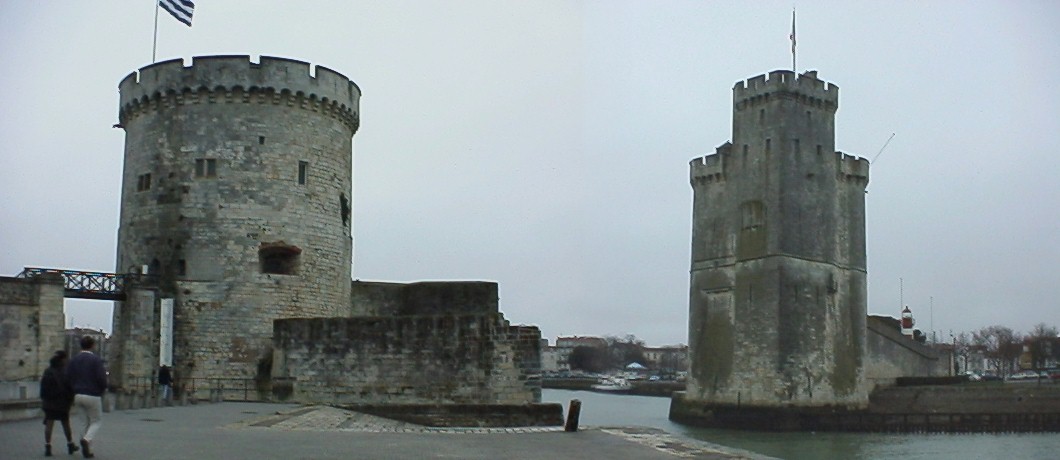
Around the World in 1998-1999; France
Note; this post is recreated from the original wired2theworld website post with the dates below. The old posts were reformatted for the 20th anniversary of wired2theworld. As much as possible, the content is unchanged and unedited from the original, only some formatting, spelling, and link errors have been corrected.
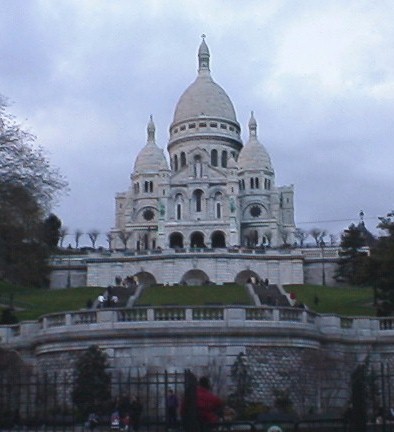
David’s Diary:
February 14, 1999
US$1= 5.6FF
We come from France…
The TGV, or Train a Grande Vitesse, is one of those things the French deserve a bit credit for- along with wines, cheeses, impressionism, the Arianne rocket program, and the guillotine. Did I mention fois gras? As we passed from the land of windmills into the land of beer and chocolate, Belgium, I wondered to myself if we can count it as a country we have been to even though we never step off the train onto Belgian soil. Probably not.
About halfway through Belgium, well away from the urban center, we enter the unrestricted speed zone, and I hear the whirring of a turbine engaging, as the French bullet train begins to accelerate. I look at Kristina and say “Watch. We are going to go really fast now.” Oh yeah? she replies, only mildly impressed. It takes a lot to impress Kristina, as those of you who know her can attest to. I am thrilled as I feel the acceleration continue, and the full power of this beautiful train stretches itself gratefully down the rails. I have had the pleasure of traveling on the Shin-kan-sen trains in Japan, the first bullet trains, but it seems to me that the TGV is even faster. The countryside is a blur as we bend hours into minutes, at speeds over 300 kilometres an hour. The trip from Den Hague to Paris, Gare du Nord, takes about three hours.
Once in Paris, I feel right at home. Both Kristina and I love this town. We had promised ourselves not to come back this trip, because it wouldn’t be the same on a budget, but the arrangements we had with Peugeot left us with no alternative. This was one of those moments than one learns how much of a difference the quality of accommodation one has really makes. A year and a half ago, Kristina and I rented the most spectacular apartment in Montmartre, right next to the Basilica. It was not very expensive, by Parisian hotel standards, and was exceptionally well equipped. It was, in effect, a very nicely done home away from home for anyone wishing to rent it. For obvious financial reasons, we could not afford this apartment on this visit, in fact we really couldn’t afford Paris at all.
We discovered the Village Hostel in the Let’s Go guide, and visited its internet site to get some idea of what it was like. On the web, it appeared to have charm and style, and advertised all of the amenities one could ever hope for in a discount accommodation. Alas, my vision of a perfect hostel was to be shattered the moment we arrived at the front door. The first thing I noticed was the scaffolding that hung to the front of the building like a recurring disease that we just cannot seem to shake. Every monument, church, palace, whatever, that we look forward to seeing is under reconstruction when we get there. It has become a running joke of grand comic proportion between us, and I say with a sigh, “it’ll probably be great in a couple of months, and whomever happens to be here then will enjoy it very much!.” At this point, I usually break down in hysterics, laughing and crying. Things didn’t get much better from that point as Kristina will elaborate.
Kristina’s Journal:
February 14, 1999 Paris, the City of Luuuvvvve…
Arriving in Paris on Valentine’s day is like arriving at Plymouth Rock on Thanksgiving. This is the City of Love, and expectations are high. So, it is a bummer when you arrive at crappy hostel that doesn’t live up to what its brochure and web site promises. We booked the Village Hostel, which is in our favorite area of Paris, Montmartre, over the telephone, after looking at its web site. True, the hostel does have a marvelous location, but it billed itself as more of a small hotel than a hostel.
We arrived, only to find that the middle of the day has a 5 hour lock out period where you cannot access your room. This is typical of many youth hostels, but mentioned nowhere in their literature. The “kitchen” was nothing more than one electric hot plate, a tiny microwave and refrigerator, set back in a room that looked like a storeroom. There were supposed to be phones in the rooms, but no outgoing calls could be made from them. The internet access promised was a coin operated kiosk. So, we could not use our computer to update the site. Dave tried approaching the owner, asking if we could use a phone line, and he told us to “go stay in a four star hotel”! At that point, I would have, but we were already paying $50 a night for a youth hostel double room, so you could imagine how expensive the hotels are there!! After looking at a few other neighborhood hotels, we decided that it was easier to stay than to move.
Instead of trying to find a nice restaurant at short notice on Valentine’s Day, we decided to wait and have a nice meal the next night. We took a walk around the neighborhood to reacquaint ourselves, and then sat outside at a great bar/cafe that is so typical of Paris, and had a couple of beers, a big plate of frites and watched the world go by.
Kristina’s Journal:
February 15, 1999
Terminus Nord
I was a bit apprehensive when we went back to Terminus Nord. All too often when I return to a place that I hold special, it is never as good the second time around. David and I went to this restaurant one late October night about a year and a half ago. Jet lagged, and hungry for dinner at 11 PM, we had read that they had a special menu after 10:30 PM. So we went, and found ourselves enamored with the 1920’s Art Nouveau decor and the heaping fruits de mer (shellfish) platters. We opted not for the late night menu, but for the full, three course menu with wine and relished every bite.
This trip, we had not planned on coming to Paris, afraid that we would not enjoy ourselves as we had before, given our limited budget. So, now that we have to be here to pick up the car, we thought we’d have at least one good meal.
The menu at Terminus Nord is large, comprising of two pages of just shellfish and seafood platters. There are two pages in the center which contain the appetizers and main course selections and then, of course, a set menu option. This menu, which is 179FF per person, is a bit expensive for the everyday budget diner, but an excellent value for a special meal. The menu includes a choice of six different appetizers, six different main courses, four desserts, and a half a bottle of wine. The food portion alone, if ordered separately, would cost over 200FF per person. The menu is reprinted and changed daily. So while we waited for our first course, we sipped a lovely Commanderie de la Bargemone white wine from Aix en Provence, and I looked again at the details of this very busy restaurant; stained glass in the ceiling, gleaming brass, art posters from the 1920’s.
Our first course came, we had both ordered oysters. These were belondine oysters, fresh from the mouth of the Belon river, and native to France. Unlike regular belon oysters that are flat, these were heavily ridged and deep cupped, much like the oysters that come from the Pacific Northwest of the US. They were cold and very briny, made even better by the tangy mignonette sauce (red wine vinegar and shallots) that always accompanies oysters in this country. We were in heaven!
For the main course, we both ordered the fresh Scottish salmon, which was served pan-roasted with the skin nice and crispy, atop a bed of spinach and sautéed oyster and shiitake mushrooms. This was cooked perfectly and tasted wonderful with the veal demi-glace that graced the plate.
For dessert I ordered chocolate, of course! This was actually a heart-shaped chocolate mousse atop a layer of chocolate nougat with raspberry sauce and creme anglaise. David had a “floating island” which is an almond-flavored meringue with almond creme Anglaise.
Terminus Nord is located directly across from the main entrance to the Gare du Nord train station at 23, rue de Dunkerque. They are open until 1 AM (as are many restaurants in Paris) and accept reservations (a good idea after 8 PM) at 01 42 85 05 15.
Note from 2020; Terminus Nord is still there and we’ve been several times since in the last two decades. Here’s a more recent experience.
February 16, 1999

I woke up determined not to let our time in Paris go to waste. Problem was, we had been here for a full week not so long ago and had then done a whirlwind of sightseeing. So, what to do? Well, there’s always the Louvre, one could spend everyday for a year there and not see it all. But we weren’t in the mood to brave the crowds so we settled on the Paris Opera House, also called the Palais Garnier, which has an interior right out of Phantom of the Opera. In fact, the eight ton chandelier supposedly fell on the audience in 1896. The famous marble grand staircase and foyers are gilded high baroque and beg to be filled with gentlemen in tuxes and ladies in fabulous ball gowns. Construction was finished on the Opera House in 1875. The auditorium is horseshoe shaped and luxe with red velvet and more gold than Fort Knox. The ceiling, from which the huge crystal chandelier is suspended, was painted in 1964 by Marc Chagall. In typical Chagall fashion, it is multi-colored and fanciful, but surprisingly, fits well into the ornate decor.
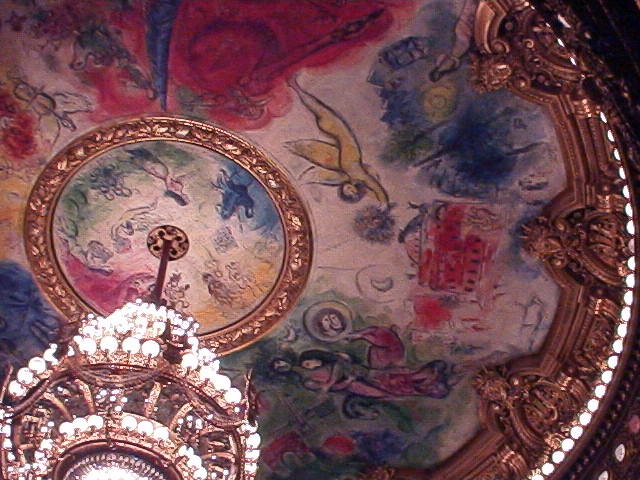
We looked into possibly attending a performance, but the only thing offered was being performed at the Opera Bastille, the newer Paris opera house. We had, unfortunately, missed a performance of Carmen, by only a few days. While inside, we discovered a new problem with our digital camera. Because the light was so dim, and what light there was bounced off every gilded surface, the camera had problems focusing on a person, rendering them blurry and the background in focus. It took us twenty minutes to get a clear photo and David wanted to throw the camera over the balcony.
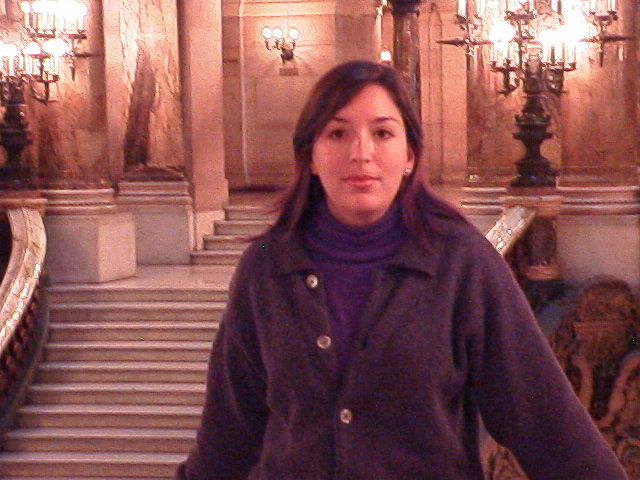
David’s Diary:
February 17, 1999 I am the Lizard King
“When the music’s over, turn out the lights” wrote Jim Morrison in one of The Doors many well-remembered songs. Ironically, for Jim Morrison, the lights are still on long after the music was over. I never knew that his following was still so devoted, or so young. The look of the fans has changed considerably over the generations, as fashion has evolved, but I found the number of kids in baggy jeans disconcerting. Not to mention the fact that almost everyone at the grave was too young to be a real Doors fan. I’m talking 14-16 year old, wet behind the ears, just out of diapers, young kids here, folks. I’m 30, for goodness sake, and I’m practically too young to be a real fan. My parents were Doors fans, they were young and hip when the Doors were together, and I was in diapers at the time! Needless to say, it was a bit odd to see the tour busloads of young kids having their pictures taken on Jim’s grave.
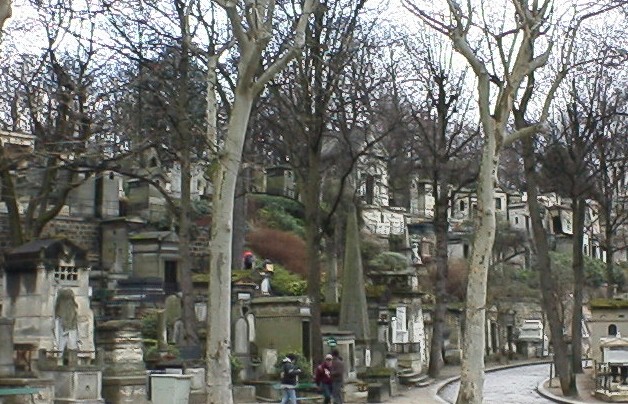
What truly disappointed me was the fact that the French government has gone out of its way to clean up the gravesite, once a work of counter cultural-artistic pride and a site where old hippies would come and pay their legitimate respects to the fallen bard. Of course, the French got tired of cleaning up the mess, busting the old hippies for smoking pot in a public place, so they sandblasted the graffiti, removed the bust, scraped up the candles, and posted two permanent guards by the headstone, who keep everyone in line, and don’t allow the shooting of video, only stills. Go figure. No longer will tourists who’ve come to see the other famous graves be scared out of their safari vests by freaks in tie-dyed overalls who are bad tripping from too much acid in an ancient graveyard, screaming about seeing the lizard, being the lizard, and how this is the end.
All this aside, I still recommend a visit to the Cimetiere du Pere-Lachaise, at the metro stop of the same name, as it is an ancient place with incredible monuments to the dead. In the vast graveyard of sepulchers and above-ground tombs and crypts, lie the bodies of such notable historic figures as Honore de Balzac, Sarah Bernhardt, Frederic Chopin, Louis David, Eugene Delacroix, Max Ernst, Rene Lalique, Edith Piaf, Camille Pissaro, Georges Seurat, and Oscar Wilde. And many more- too many to mention them all here. The most impressive aspect of this place is the detail of the tombs themselves. Some are ancient monuments in their own right, with gothic architecture worthy of an oooh, ahhh. Others are simply beautiful, with ancient stained glass, and little chapels with ornate sculptures. It is enough to make one start planning their own gravesite.
Kristina’s Journal:
February 17, 1999
Today was one of those days necessary in every long term traveler’s itinerary; and day to run errands and take care of business. The first business of the day was the laundry which wasn’t difficult, only time consuming. We went to the post office and mailed home a box which weighed not more than 3 kilos and cost us over $40 to mail home. Ouch! These are the things we forgot to budget for. We had to go in search of the Bank of France as well. When we were in Taiwan, Bill had given us 100FF in old bills from 1974. The currency has since been changed, but we were lucky, we were able to cash them in for a straight exchange.
Our dinner that night restored my faith in the concept that it is possible to eat out in Paris inexpensively. We ate in Montmartre at a restaurant called L’Esterel which had a 52FF menu. This was basic food, but well done. I had a sliced avocado for an appetizer, and the classic steak frites and David had pate de campagne and lamb. We each had chocolate mousse for dessert and all was well. The restaurant was packed with locals and tourists alike and sits right around the corner from the base of Sacre-Coeur.
David’s Diary:
February 18, 1999 Which way to Le Mans?
We found our way to the Sodex Peugeot Dealership at La Defense de Paris without too much trouble. They were expecting us. I like that. We knew it would take them about an hour to process the paperwork, so we were not surprised when they told us the same. The paperwork was not so bad, from our end, as all we had to do was sign about twelve different things, twice, and that was it. Then, one of them had to take it down to the appropriate government office and register the car. I became, in the space off one hour, the owner of a new car! And what a cool little car it is. I have never been fond of late model French cars, although older Peugeots, Renault 2cvs, and Citroens have a lot of style. For the most part, the last twenty years of French automobile design has been uninspired.
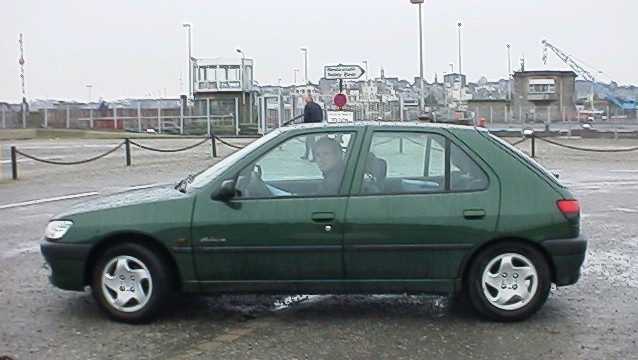
When I first saw the forest green Peugeot 306 that I now “own”, I was pleased that it was not white, like most small euro cars. It did not impress me, but neither was I disappointed. It was bigger than the average dinky euro boxy car, and had a nice set of wide tires and a body design that flared out at the axles, creating a wider wheelbase. More stability and better handling. I was happy.
We get in, and I turn the key. It rattles like a diesel. It is, of course, a diesel. But, it is a 1.9 litre, 16 valve, Turbo Diesel! Turbo! You can bet I was planning to milk the turbo thing for all it could give- acceleration wise. Having experienced diesel engines with our campervan in New Zealand, I know that they are more fuel-efficient, but they tend to lack guts and speed. They have climbing power but at a snail’s pace. That is, a diesel can haul three times the weight of a standard engine, but at one fifth the speed, and if it has to stop going uphill, forget it. Not our little 306. This little car has sold me on the merits of a diesel engine. The first time I punched the pedal to the floor and was sucked into my bucket seats by the acceleration, I was a believer. Which way to Le Mans? Monte Carlo? Look out Dale Earnhardt.
Not only does our little car have pep, but it has all kinds of neat extras that I have never seen on new American cars. The first thing we discover, as we head off into the rainy afternoon is that the car has smart window wipers. Most cars have an intermittent wipe setting that wipes at intervals of 3-10 seconds, as well as lo and hi wipe. But this car has a setting called Automatic instead of that. On auto, the rain sensor in the windshield detects the strength of the rain and only wipes when necessary, changing speeds as the conditions change, and stopping as the rain stops. You can forget about it as soon as it stops raining, and then, whap!, a truck splashes your window and swish swish, it’s gone. Presto, smart wipers.
Tricky item number two: Radio tuner and volume control on the steering column. The car comes with a standard radio cassette, by Clarion, but has an additional control just beneath the wiper arm for the stereo. This quad- directional lever goes up and down to adjust volume, and back and forth to change stations on seek mode! A driver never has to take their eyes off the road or their hands off the wheel to mess with the radio, thus reducing the number of stereo related accidents on the road. Of course, getting used to this newfangled technology was difficult at first. I would try to change stations, and the wipers would go on, the signal for a left turn and change from rock to classical instead, and turn up the volume instead of activating the rear window wipers, but I had it all sorted out after a few thousand kilometres.
Item three was a mystery until I was driving at night and decided to play with some of the dials I hadn’t yet messed with. A philosophy of life I believe in is: “If there are buttons, they were meant to be pushed, If there are dials, they were put there to turn, If you work in a Nuclear Missile Silo, please disregard.” So while turning the dials, I discovered that the headlights on our vehicle were adjustable. There are four settings for the headlights, and they correspond to different states of heavy loads in the vehicle, assuming that the angle of the front will change depending on the distribution of weight in the car. No more confusing screwdriver adjustments to change the angle of the headlights, just a switch. Plus!, the car has standard fog lights in the front and rear, all on independent switches.
Kristina’s Journal:
February 18, 1999 A Car is Born….
…and it’s and brand new baby Peugeot 306 with 14 km and that New Car Smell…
Up and out early this morning with all our stuff. One long metro ride, one short bus ride, and a short walk and we arrived at the offices of Auto France, the Peugeot office on the outskirts of Paris. After filling out all the various paperwork, and waiting about an hour and a half for the car registration to go through, we were soon the owners of a brand new car! Owners, with the understood agreement that we would be “selling” the car back to the company in 90 days. Our credit card was charged only for that 90 day duration of owning the car. Included in the price is total comprehensive insurance, 24 hour roadside assistance, and that new car smell! The car turned out to be dark green, compact ,but not so small as to worry about our safety, and with plenty of room in the hatchback/trunk for our luggage to be out of site.
Out on the open road the car performs extremely well, getting decent mileage with diesel gas, yet not sacrificing speed or acceleration. We later christen the car PIA (Peugeot International Airlines) as Dave attempts to take the car into Warp Speed.
About an hour out of Paris we make a horrible discovery; I have forgotten the new Frommers French Food guidebook we bought in Paris back at the hostel. This was an excellent book covering all the regions of France and their gastronomic specialties and I was extremely distressed. Disheartened, we called the hostel and were told that no one had seen it. The maid had just cleaned the room and saw nothing. The desk clerk said he looked for it as well and could not find it. I was even more upset to realize someone there had to be lying, because I know for a fact it had to have fallen under the bed. Bummed, we decided it wasn’t worth heading back to look for ourselves and press onward toward the Brittany coast.
It was almost dark when we arrived at the walled city of Saint Malo on the Northern Brittany Coast. We walked around the town a bit before finally settling on a cute little hotel right inside ramparts called the Pomme d’Or. We had dinner in the hotel, picking it primarily because the menu had a dozen fresh oysters as an appetizer course option. These turn out to be the best part of the meal; the rest being mediocre at best.
David’s Diary:
February 19, 1999
St. Malo
We drove all day through torrential rain, on little back roads to reach to coast and the quaint little village of St. Malo. Just about 20k to the west of the famous Abbey, Mont St. Michel, St. Malo is a bustling port town with two distinct looks. On the one hand, it is a modern seaside town, nothing special, with plenty of working folks who don’t give a hoot about tourism. If one keeps driving towards the port, however, they will be amazed as they round the final bend and look out at the old walled city. Out on the peninsula lies the extremely well preserved old city of St. Malo. It is completely surrounded by its original fortifications and all of the buildings within date back to the same era. All of the walls around the town are accessible from the street below, so a person can walk the circumference of the town on top of the fortifications, along paths like the one in the picture below.
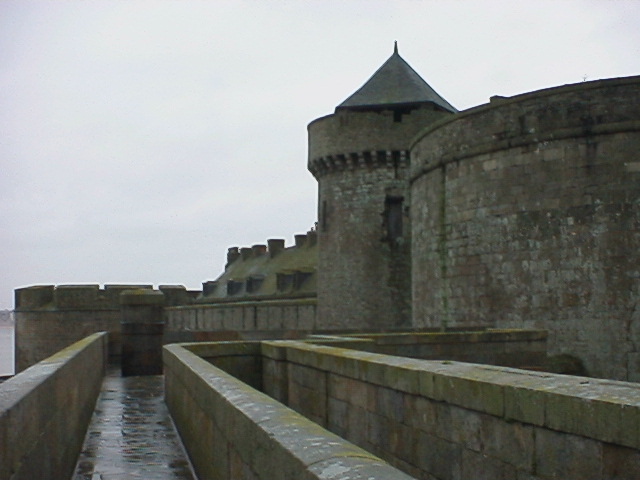
The setting is truly stunning here, and has no comparison in our young nation that I am aware of. There is only one thin road to the old city, which is almost an island but for the little spit of land that connects it to the mainland. I can see immediately why this town has survived, as it is well planned for defense. There are three arched gates through which a small auto can pass into the inner sanctum, and then wind its way along a maze of ultra thin one-way streets. But for the cars, and the electricity, it is easy to imagine that I have been transported to the 16th century, as we walk around the virtually unchanged streets of this quiet town in search of lodging.
We are lucky enough that it is low season, as the hotels are not all full, and their rates are somewhat cheaper than they are in high season. We have little trouble settling on a nice little hotel next to the wall. Within the confines of the city, one doesn’t find a whole lot going on, but there are more restaurants than a body can count, and all of them have what we are looking for: seafood! Oysters, in particular, are especially good in this part of France, and this is the season! We will eat them by the dozen every night.
In addition to its charm as a town, there are a few more interesting notes about St. Malo. It is one of those places on the Earth that has extreme tidal shifts. We’re talking really extreme here, folks, not just big. There is a jetty that runs out from one corner of the town into the harbor, from which we took the great panorama picture below.

When I first saw this jetty, from the top of the city wall, the tide was out, and the jetty looked to me like a wall on dry land. When we took the picture, the tide was high and the water reached all the way to the city foundation. The boats in the harbor are stranded on dry ground when the tide goes out! Wait, there’s more! On the other side of town, there is a famous beach, where summer vacationers go swimming and to lay out, but there are signs posted with skulls and crossbones informing visitors not to swim around high tide, because the water will sweep you out to sea as the tide goes out.
There is a giant saltwater swimming pool erected on this beach, with a multi level high diving tower. When I first saw this pool, it was low tide and I could barely see the ocean in the distance. How neat, I thought, a pool so one doesn’t have to walk to the ocean. Then, at high tide, I saw the same spot, but no pool! The whole darn thing was underwater – that’s how it gets filled, I guess- and only the handrails at the top of the diving platform were visible between waves! I had a new understanding of those warning signs.
Also, there are three small islands (sometimes hills, other times islands) off the coast of the town, behind the pool, two of which host magnificent castles and ruins. There are footpaths upon which to walk out to these sites, but be careful! The signs warn visitors not to attempt the traverse within 30 minutes of a tidal shift, as others have been caught trying to walk across when the tide outran them and swept them away to their deaths. Pleasant, n’est-ce pas? Final analysis, St. Malo ranks up there among the very best destinations in all of France.
Kristina’s Journal:
February 19, 1999
On our second day on the road, we went in search of a cooler to put in the back seat of the car to keep snacks and food for lunch. We looked all over, in at least half a dozen stores and finally figured out this was considered a “seasonal” item, and not for sale until the spring. In fact, even with David speaking French, we had a hard time convincing anyone what it was exactly we wanted. Finally, in a sporting goods store, we found one (the only one they had)! Success! In the rain, we checked out the walls of St. Malo upon which it is possible to walk all the way around the top.
That night, we had dinner in Les Remparts, a restaurant actually inside the wall surrounding St. Malo. Again, with the exception of fresh oysters, the meal was also mediocre. Maybe I’m weird, but I expect better food out of French chefs. That had to be the absolute worst bearnaise sauce I’ve ever had!
The following morning, before we leave St. Malo, we put our new cooler to work and walk around the town purchasing the bits and pieces for our lunch. Bread from the bakery; fresh butter and three different cheeses from the creamery; fresh roast beef and pate from the rotisserie shop and we were set! We had planned on buying oysters from the seafood vendor, but the weather was so poor we would not be able to eat them outside and didn’t want to risk the mess of opening them in the new car.
David’s Diary:
February 20, 1999 Mont Saint Michel
From a distance, in the evening haze, Mont St. Michel looks like something out of Arthurian legend (see photo page) Rising out of the water on a lone rock in an otherwise flat and sandy stretch of beach, is one of the most impressive sights one could ever hope to see in real life. The towers of the abbey reach straight up to the heavens, and the its look is one of medieval splendor and mystery. I half expected a dragon to come swooping out of the fog, with Gawain Lancelot in hot pursuit. One reaches this little spot of magic along a raised bed road, complete with tidal warnings similar to those at St. Malo. “Watch the tides”, they read, posting the hour of the next high tide, “as this parking lot will be under six feet of water at…” and there goes your new car smell!
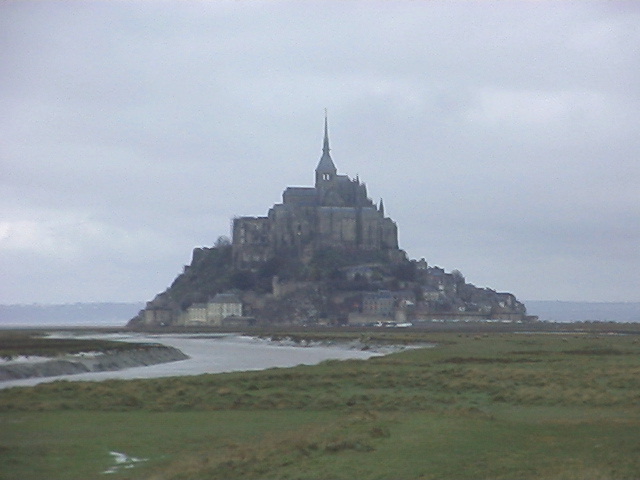
Once inside the walls of this bizarre place, Kristina and I were a bit let down. Not that it wasn’t spectacular, as the thin cobbled streets wind in a spiral up towards the ancient fortress and Abbey that watched over them, once upon a time. It was all that, and more. However, it seemed to us that Walt Disney and company, or the french equivalent had beaten us there, as every doorway was a clone of the last with overpriced tourist food or the same souvenirs. The result is that Mont St. Michel was better from a distance, at least for us, than it was up close. We will have to go back someday, and go inside the abbey, but on this trip, we were too put off by the crowds of tourists and the inflated prices of everything, from parking (20 francs) to the abbey’s entrance fee of 40 francs each (no student discount, either). Still, it is a sight worth visiting, especially on your way to or from St. Malo.
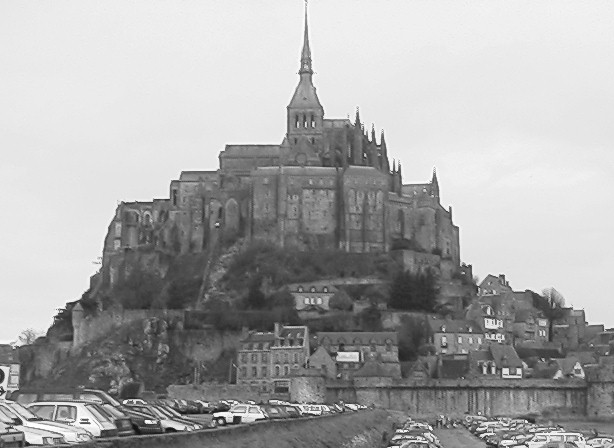
| Kristina’s Notes; Of Motels, Cafeterias and Hyper-Markets.. (Or, How to Save $$ driving through France) |
| In a desperate act to save a little money, we discover the French version of Motel 6 and Denny’s; the motel chain Premiere Classe Hotel, and the Toquenelle Cafeteria. These motels are an interesting phenomena. Their office is closed in the middle of the day and late at night, but the rooms can be accessed 24 hours a day with a credit card at a machine outside that looks like an ATM. The rooms are box-like and sterile, and bathrooms look like an airliners’, but they exist on the auto routes outside the bigger cities and they are cheap; 159 FF a night for up to 3 people. This allowed us to sleep cheap and then check out the sights of the town in the morning and be on our way. This is a great alternative if you are traveling by car with 2-3 people. The other phenomenon we found was the hypermarche, this is a huge supermarket something like a Wallmart with a supermarket attached to a mall. In the mornings, we would stop at the hypermarche and fill up our cooler with lunch fixings and snacks to eat on the road. There we found the Toquenelle Cafeteria where we both could eat a decent meal for 100 FF for two of us, including wine. Ok, I can hear my gourmet snob friends groaning now, “you go to France and eat in a cafeteria???”. In my defense, I have to say, this is where the locals eat, the food wasn’t that bad, and hey, on our budget, not every meal can be three stars. |
Kristina’s Journal:
February 21, 1999 La Rochelle
Since we had spent the night outside of town, in the morning we drove in to check out the lovely 14th century city of La Rochelle. The main attraction were the three Medieval towers, but unfortunately, they charged admission of 40 FF per person for access. We thought about it, but chose to just admire them from the outside instead, not wanting to see yet another cold, empty, stone room.
We spent way too much time during the rest of the day driving all over the coast in the rain, seeing, not much else. We wound up in Perigeux with another motel and cafeteria dinner and a plan to see the famous caves of the area the next morning.

February 22, 1999 The Caves…

This area of southwest France is filled with limestone caves many of which were inhabited in Prehistoric times. The most famous of the caves is Lascaux, which was discovered at the turn of the century and filled with prehistoric cave paintings. Unfortunately, due to poor planning and the effects of years of tourism, the caves at Lascaux are now closed to the public. However, there are still other interesting caves in the area that are open with limited availability. We were able to see two on this day; La Roque Saint-Christophe and the Grotte De Font-De-Gaume.
As we drove around the the rain, we passed by several sites in the area that were either “closed for the season” or closed due to the simple fact that it was Monday. Consulting our guidebook, we headed toward the Roque Saint-Christophe, the only one we thought would be open. This turned out to be a huge limestone cliff that has been inhabited from pre-historic times until the 17th century. It sits high above the Vezere Valley, and has five levels carved into the cliff face that at one time housed up to three thousand people.
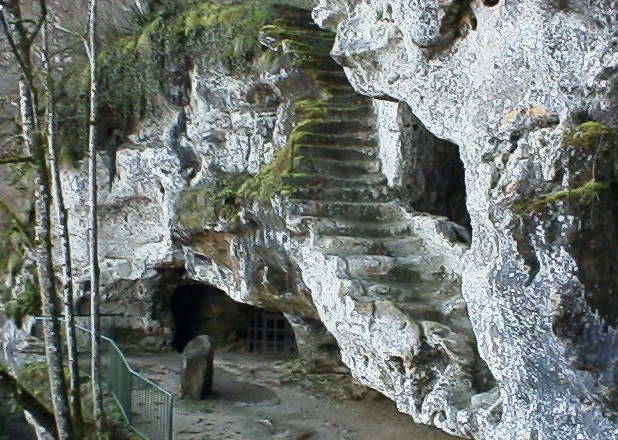
We paid our admission and were given a plastic-coated comic book/ guidebook, in English, to help us make our way through the mammoth structure. We saw areas that once housed a butcher, where animals were held, and even an area that was obviously used as a kitchen, There are reconstructions to show how wooden houses were built into the cliff and where a medieval fortress and church had been carved into the stone. All fascinating.

As we left, we spoke to the lone woman at the entrance booth about our disappointment at not being able to see any cave paintings. She told us that, yes, Lascaux was indeed closed to the public, but they did let six people in a week with special appointment. A duplication has been created for tourists called appropriately, Lascaux II, but it is closed on Mondays. However, she told us, contrary to our information, the caves at the Grotte De Font-De-Gaume were open today.
We raced over there, to the tiny town of Les Eyzies, and arrived just in time to get admission tickets for the last tour of the day. Due to strict climate control, admission is only allowed by guided tour and only 100 people are allowed in each day. The Grotte De Font-De-Gaume is the only paleolithic cave in Europe with cave paintings still open to the public. The tour was conducted in French, by two women who stood at each end of the group making sure no one touched anything either accidentally or on purpose.
First we walked through very narrow passages until we reached the first cavern which is 120 meters long and contains over 200 figures. The interior is quite dark, as the paintings need to be protected from light damage. The guide showed us by flashlight how the people who created the paintings of bison, horses, and reindeer used the natural shape of the rock to contribute to the form of the animal. The animals are shown overlapping one another and there is even a painting of a deer reaching out with its tongue to lick another deer on the face. This is the first indication of any tenderness or emotion being shown in art. She noted that such realism in art is not seen again for thousands of years. Unlike what many people believe, these are not portraits of the hunting glories of the artist for there are no weapons seen in any of the paintings. Of course, no photos were allowed, so we are unable to show you any pictures.
That night we tried a new motel, called B and B, which was much better quality for only $2 more. We had dinner in a worse cafeteria and vow to have a better meal tomorrow.
David’s Diary:
February 23, 1999 From Bordeaux Wine Country…
When Kristina and I got married, back in the dark ages, before Monica-gate and the new enlightenment (full measure of sarcasm intended), we were blessed with many friends and relatives and gifts. One old family friend give to us a case of truly awesome Bordeaux. It is a case of 1990 Chateau Batailley, Paulliac, a Grand Cru Classe. Alas, we have only eleven bottles of this marvelous wine left, as we consumed one just before our third anniversary. Yes, we waited three years before touching the first bottle of this wine, and even that was pushing it. 1990 was an exceptionally good year for the big wines of the Medoc, Bourdeaux, home to the best wines on the planet.
Most of our readers will recognize names like Chateau Mouton Rothschild, Chateau Lafitte Rothschild, Chateau Latour, and Chateau Pichon Longueville, but there are some lesser know names of equally good wine in Paulliac, such as Batailley. To be a Grand Cru Classe is to have one hundred and forty four years of history as one of the most revered wines in France, and in all of Bordeaux there are only a few. Beyond that, there is only one higher classification, which is Premiere Grand Cru Classe, of which there are only three: Latour, and the two Rothschilds, all of which are Paulliac. If your wine says Cru Classe, Cru Bourgeois, or Cru Artisan, on the label, do not fret, it is probably excellent.
Just to be recognized as Cru anything back when this system of wine snobbery was made official in the 1800’s, is to be worthy of any wine connoisseur’s respect. If your wine has a date on it (it should, unless it came in a box) such as 1998, 99, 90, 94, or 95, put it away! Cellar it in a dry cool place, on its side for, oh lets say, at least ten years, then open it with love. Don’t gag on my snobbery here, I’m totally serious. The bottle of 1990 Batailley we had before leaving on this voyage was great, but oh so young. It was like ( and don’t take this the wrong way) statutory rape of a great vintage. It will mature with time and careful storage, and be an experience to remember.
So, why am I bothering to share this story with you? Because we found ourselves in the heart of this great wine region, and decided to drive up the coast a little and visit our cherished vineyard. The drive up into the Medoc, as it is known, which lies along the south banks of the Gironde, where the Dordogne and Garonne rivers meet and venture forth into the Atlantic ocean, is well worth the time.
Although we found that in the offseason, the vineyards are all closed to the public, and practically deserted, as are the small towns along the way, the route itself is beautiful. Imagine winding your way through picturesque village after village, flanked by the vines which bear the most wonderful fruit known to wine lovers, and every thirty seconds there is another beautiful castle. Fantastic manor after Cinderella Castle, after grand noble estate, each representing one of the greatest wines on earth. I was in awe as I read the signs. “Look it’s such and such” and “Oh wow, we just passed chateau so and so”. I felt like David XIV, surveying the royal landscape. We will go back someday, and buy wines by the case after we visit a few vineyards and taste the fare. Kristina says I have to make a few million first, but I am sure they take Visa!
Kristina’s Journal:
February 23, 1999 ….to Bayonne, French Basque Country
Since there was not much going on the the off season up in wine country, we decided to stay in Bayonne which is a French-basque town near the Spanish border. We drove around in circles (per usual when we enter a new town with no map), and finally parked the car in the town center across the street from the train station. After walking around a bit and checking out the pensions, we finally settled on our first dismissed option, the Hotel Paris-Madrid (right across the parking lot from the train station). This hotel, recommended by our guidebook, turned out to be a good choice. For 160 FF we had a nice little room that had a phone and a bathroom. The owners were extremely nice and speak English, French, and Spanish.
For dinner we chose to go by the book’s recommendation again and go across the plaza in front of the train station to Le Bistrot Ste-Cluque. There, David got to satisfy his craving for fois gras de oie mi cuit that he has had the entire way through France. Since this is a specialty of the region, and one of his favorite dishes, we couldn’t pass it up. He followed with lentil soup with smoked sausage and salmon pasta alla Calabrese. I had a lovely salad with artichokes and jamon serrano and for my entree, duck thigh confit with roasted potatoes.We ordered a great bottle of Spanish wine, a 1991 Marques de Tosos reserva, Denomin Cariñena, and toasted to not eating cafeteria food again.
Have you been to France? Thinking of going?
Leave me a comment below and make my day!
You can also find our other travels within France here.
Any post on this site may contain affiliate links. Thank you for supporting wired2theworld by using our links to shop, book hotels, or organize tours. If you use them, they cost you nothing extra but we may make a small commission that helps us to continue to provide helpful and free content.

